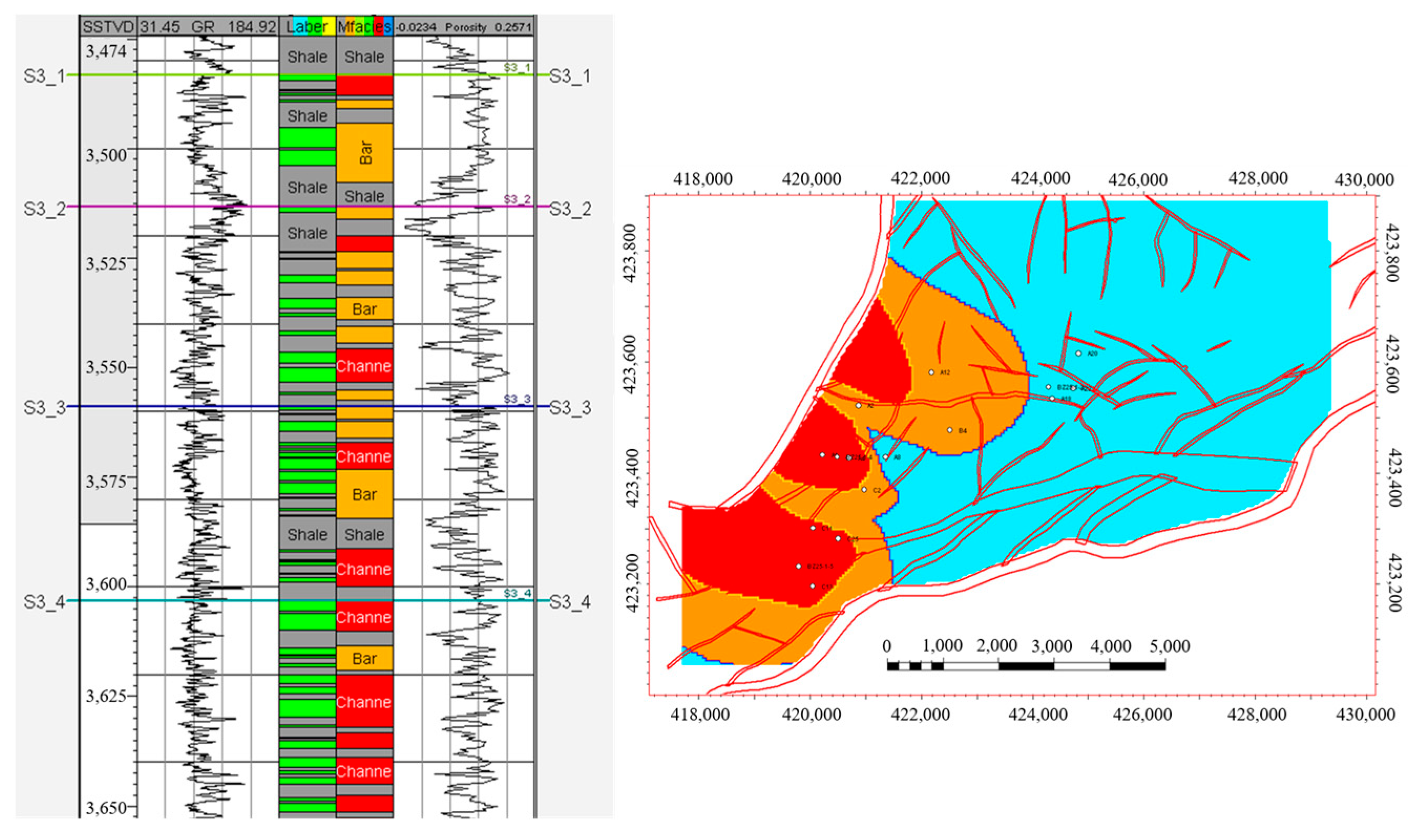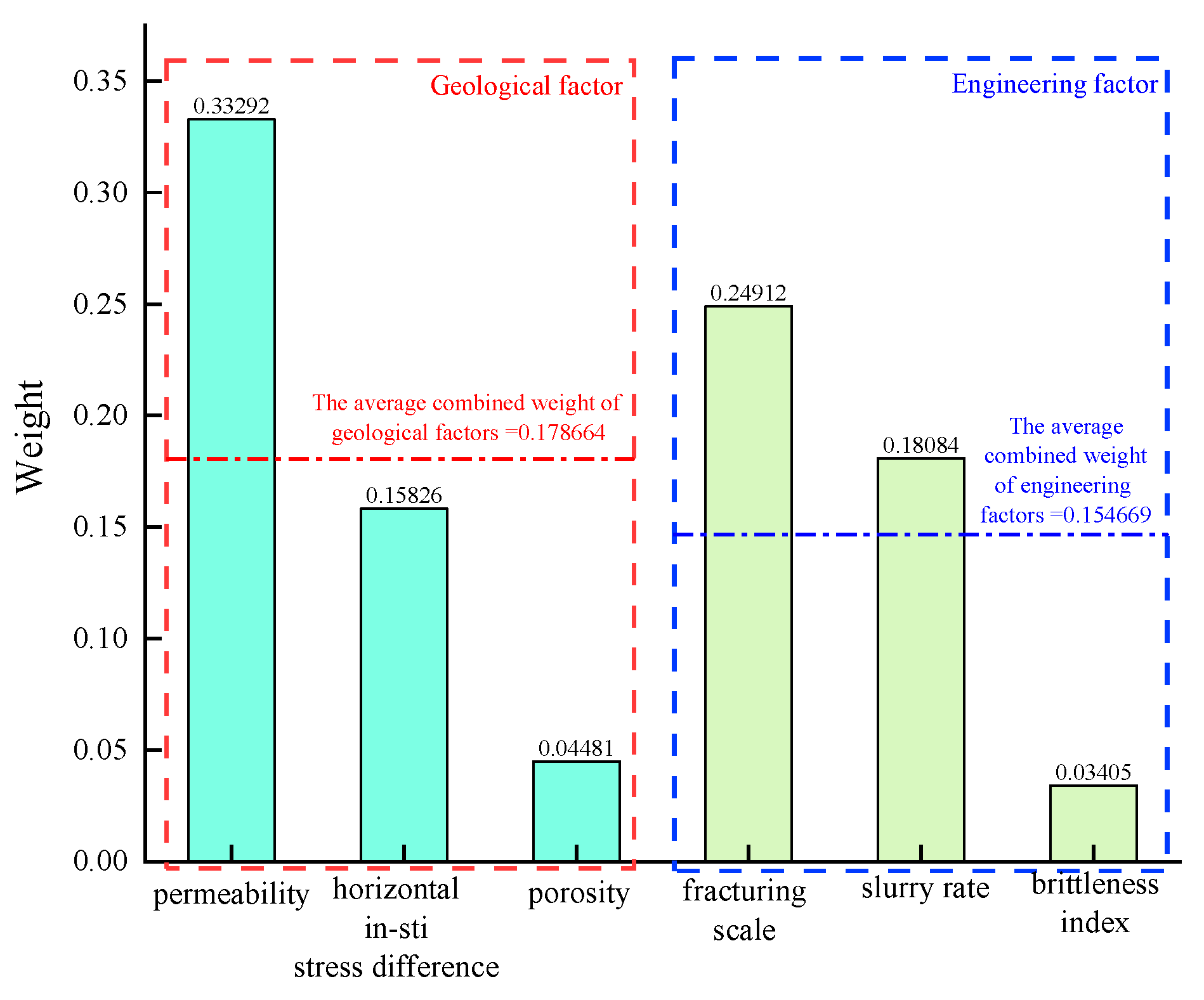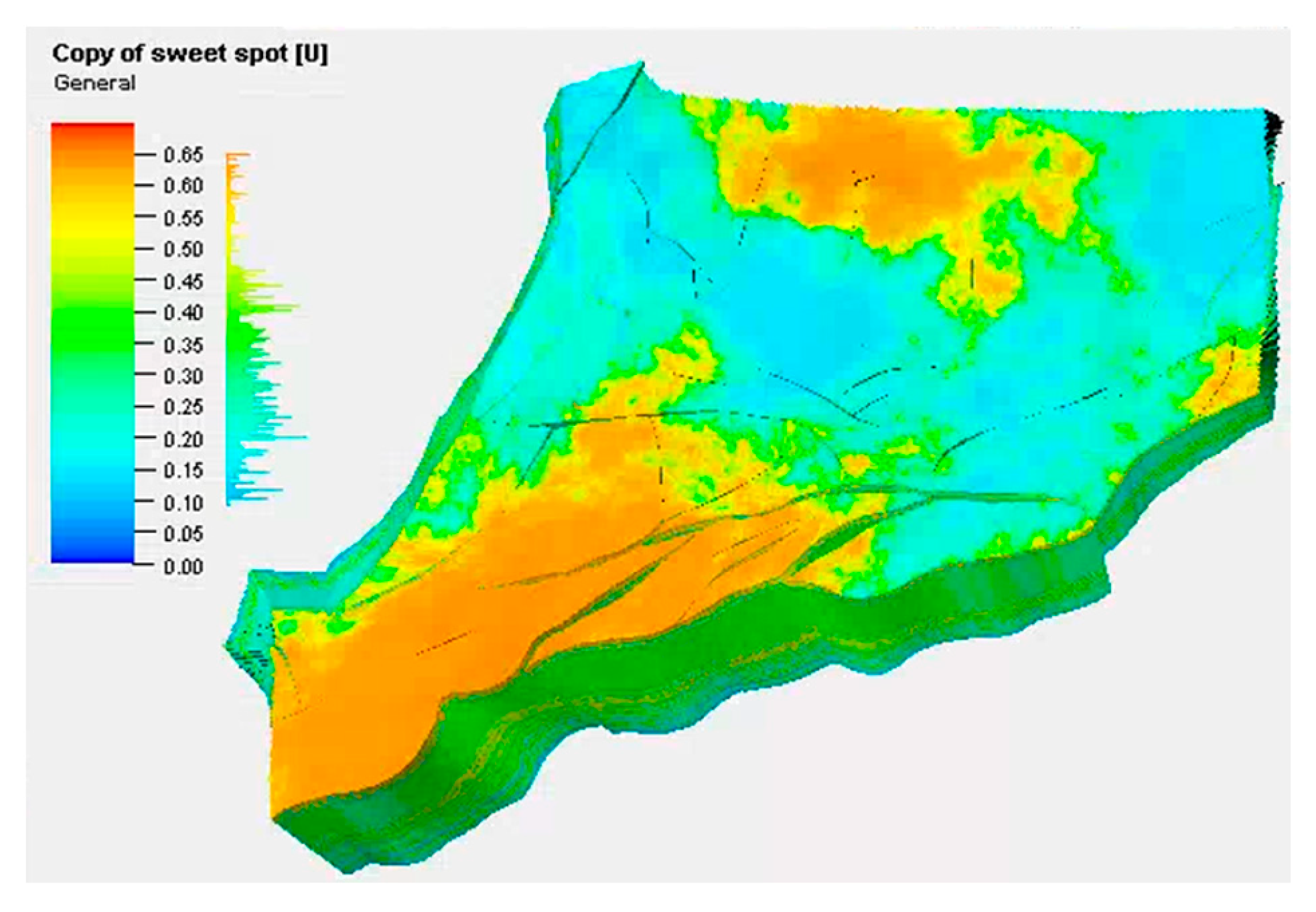A New Approach to a Fracturing Sweet Spot Evaluation Method Based on Combined Weight Coefficient Method—A Case Study in the BZ Oilfield, China
Abstract
:1. Introduction
2. Geological Settings
3. Analysis of Geology–Engineering Parameters
3.1. Geological Parameters Analysis
3.1.1. Study of the Reservoir’s Physical Property Parameters
3.1.2. Study of In Situ Stress
3.2. Engineering Factors Analysis
3.2.1. Study of the Brittle Index
3.2.2. Pump Rate
3.2.3. Fracturing Scale
4. Construction of Combinatorial Weight Evaluation Model
4.1. Standardized Processing of Raw Data
4.2. Model Construction
4.3. Construction of Combinatorial Weight Model
5. Result Analysis and Discussion
5.1. Application
5.2. Verification
6. Conclusions
- Based on combination weights, the most influential factors on post-frac production, are, successively, permeability, fracturing scale, slurry rate, horizontal principal stress difference, porosity, and brittleness index. The corresponding weight coefficients are 0.33, 0.25, 0.18, 0.16, 0.045 and 0.034.
- The geological factors have a greater impact on production than engineering factors.The average weight of geological factors is 0.18, while that of engineering factors is 0.15.
- There is a strong correlation between production and the dual sweet spot index Z which the correlation coefficient is 0.96. The anastomosis rate is 80% after comparing predicted and actual production from each well.
- To achieve better fracturing effects, it is recommended to select the fracturing spots in formations with good reservoir physical properties. Additionally, the fracturing treatment design should consider the limit of equipment and string performance while increasing fluid and sand volumes for optimal fracturing scale.
Author Contributions
Funding
Data Availability Statement
Conflicts of Interest
References
- Sun, F.; Xu, W.; Jiang, W.; Zhen, Q. Progress and prospect of reservoir reconstruction technology for low-permeability and unconventional offshore oil reservoirs in China. China Offshore Oil Gas 2024, 36, 109–116. [Google Scholar]
- Xu, C.; Lai, W.; Zhang, X.; Zhang, J. New progress in oil and gas exploration of CNOOC and thinking about future exploration. China Offshore Oil Gas 2023, 35, 1–12. [Google Scholar]
- Guo, X.; Liu, Q.; Wang, Z.; Wang, X.; Han, L.; Wang, J. Optimal design method of the scale of pressure and fracture plugging in the offshore unconsolidated sandstone reservoir. J. Xi’an Shiyou Univ. (Nat. Sci. Ed.) 2022, 37, 53–59. [Google Scholar]
- Shi, J.; Jin, Z.; Liu, Q.; Fan, T.; Gao, Z. Sunspot cycles recorded in Eocene lacustrine fine-grained sedimentary rocks in the Bohai Bay Basin, eastern China. Glob. Planet. Chang. 2021, 205, 103614. [Google Scholar] [CrossRef]
- Vikara, D.; Remson, D.; Khana, V. Machine learning-informed ensemble framework for evaluating shale gas production potential: Case study in the Marcellus Shale. J. Nat. Gas Sci. Eng. 2020, 84, 103679. [Google Scholar] [CrossRef]
- Sui, L.; Ju, Y.; Yang, Y.; Yang, Y.; Li, A. A quantification method for shale fracability based on analytic hierarchy process. Energy 2016, 115, 637–645. [Google Scholar] [CrossRef]
- Zhang, C.; Xia, F.; Xia, Y.; Zhou, X. Comprehensive evaluation of compressibility of tight sandstone reservoirs based on analytic hierarchy process. Drill. Prod. Technol. 2021, 44, 61–64. [Google Scholar]
- Zeng, F.; Cheng, X.; Guo, J.; Tao, L.; Chen, Z.; Wang, M. Hybridising Human Judgment, AHP, Grey Theory, and Fuzzy Expert Systems for Candidate Well Selection in Fractured Reservoirs. Energies 2017, 10, 447. [Google Scholar] [CrossRef]
- Chen, Y.; Wang, L.; Li, F.; Zhang, L.; Yang, F.; Ma, Z.; Gao, Z. Prediction of low-rank coalbed methane development constituency based on random forest algorithm. Pet. Reserv. Eval. Dev. 2022, 12, 596–603+616. [Google Scholar]
- Han, Q.; Zhang, X.; Shen, W. Lithology identification based on gradient lifting decision tree (GBDT) algorithm. Bull. Mineral. Petrol. Geochem. 2018, 37, 1173–1180. [Google Scholar]
- Wang, Y.; Zhou, Y.; Yuan, H.; Li, X.; Ma, L.; Lu, C. Analysis of influencing factors of fracturing effect in Bin 425 block based on grey correlation method. Well Test. 2021, 30, 73–78. [Google Scholar]
- Qu, Z.; Huang, D.; Mao, D.; Li, H.; Yang, Y.; Yan, J.; An, S. Analysis of influencing factors of fracturing effect of low permeability gas reservoir based on grey correlation method. J. Northwest Univ. (Nat. Sci. Ed.) 2014, 44, 603–609. [Google Scholar]
- Nie, L.; Zhou, D.; Guo, X.; Hui, J.; Bian, J.; Gao, L. The influencing factors of fracturing in low permeability gas reservoir are analyzed by grey correlation method. Fault Block Oil Gas Field 2013, 20, 133–136. [Google Scholar]
- Xia, H.; Wang, H.; Zhao, H. Identification of Shale Gas Geological “sweet spot” by Logging Multi-parameter two-vector Method. Nat. Gas Ind. 2017, 37, 36–42. [Google Scholar]
- Liao, D.; Lu, B.; Chen, Y. Evaluation method of shale gas geological sweet spot: A case study of Jiaoshiba shale gas field in Sichuan Basin. Acta Pet. Sin. 2019, 40, 144–151. [Google Scholar]
- Zhang, W.; Xiao, Z.; Yi, H.; Jiang, M.; Zhu, Y. Application of “double sweet spot” identification method for tight sandstone reservoirs in Paleogene reservoirs in Lufeng area, eastern South China Sea. Geophys. Prospect. Pet. 2024, 63, 217–228. [Google Scholar]
- Liu, S.; Chen, G.; Lou, Y.; Zhu, L.; Ge, D. A novel productivity evaluation approach based on the morphological analysis and fuzzy mathematics: Insights from the tight sandstone gas reservoir in the Ordos Basin, China. J. Pet. Explor. Prod. Technol. 2019, 10, 1263–1275. [Google Scholar] [CrossRef]
- Li, Y.; Zhang, Y.; Liu, G.; Yu, J.; Yang, Z. Analysis of factors affecting production of coalbed methane Wells after fracturing based on combination weights. Spec. Oil Gas Reserv. 2020, 27, 115–120. [Google Scholar]
- Tang, S.; Zhu, W.; Zhang, J. Productivity analysis and optimization of fracturing parameters of transitional phase shale gas reservoirs in Zhongmu Block. Chin. J. Eng. 2020, 42, 1573–1587. [Google Scholar] [CrossRef]
- Wang, Q.; Deng, Q.; Zhou, J.; Zhang, Y.; Geng, H. Evaluation of the development effect of fractured horizontal Wells in offshore ultra-low permeability reservoirs: A case study of Well area 5, Member 3 of Sha-3 Member, BZ Oilfield, Bohai Sea. Complex Hydrocarb. Reserv. 2022, 15, 74–77+104. [Google Scholar]
- Qiao, J.; Zeng, J.; Jiang, S.; Feng, S.; Feng, X.; Guo, Z.; Teng, J. Heterogeneity of reservoir quality and gas accumulation in tight sandstone reservoirs revealed by pore structure characterization and physical simulation. Fuel 2019, 253, 1300–1316. [Google Scholar] [CrossRef]
- Liu, S. A New Fracability Evaluation Approach for Shale Reservoirs Based on Multivariate Analysis: A Case Study in Zhaotong Shale Gas Demonstration Zone in Sichuan, China. Acta Geol. Sin. (Engl. Ed.) 2019, 93, 1005–1014. [Google Scholar] [CrossRef]
- Cipolla, C.L.; Warpinski, N.R.; Mayerhofer, M.J.; Lolon, E.P.; Vincent, M.C. The relationship between fracture complexity, reservoir properties, and fracture treatment design. SPE Prod. Oper. 2008, 25, 438–452. [Google Scholar]
- Tarasov, B.; Potvin, T.Y. Universal criteria for rock brittleness estimation under triaxial compression. Int. J. Rock Mech. Min. Sci. 2013, 59, 57–69. [Google Scholar] [CrossRef]
- Rickman, R.; Mullen, M.; Petre, J.; Grieser, B.; Kundert, D. A practical use of shale petrophysics for stimulation design optimization: All shale plays are not clones of the Barnett shale. In Proceedings of the SPE Annual Technical Conference and Exhibition, Denver, CO, USA, 21–24 September 2008. [Google Scholar]
- Zhang, D.; Ranjith, P.G.; Perera, M.S.A. The brittleness indices used in rock mechanics and their application in shale hydraulic fracturing: A review. J. Pet. Sci. Eng. 2016, 143, 158–170. [Google Scholar] [CrossRef]
- Sun, F. The method of grey relational degree analysis and its application are briefly discussed. Sci. Technol. Inf. 2010, 17, 880–882. [Google Scholar]
- Wang, H.; Liu, Y.; Zhang, X.; Gou, W.; Yu, R.; Sun, Y.; Liang, P.; Kang, L. Evaluation of integrated geological engineering of shale gas reservoir desserts based on analytic Hierarchy process: A case study of well X area in Haiba area of Taiyang Shale Gas Field, Zhaotong Shale Gas Demonstration Zone. Earth Sci. 2023, 48, 92–109. [Google Scholar]







| Formation | Member | Bottom Depth (m) | Thickness (m) | Petrographic Summary |
|---|---|---|---|---|
| Shahejie | Sha 1 | 3717.0/3342.0 | 71.0/69.0 | It is a large set of gray mudstone segments. Two layers of phosphor siltstone are seen below. |
| Sha 2 | 3797.0/3420.0 | 80.0/78.0 | Fluorescent fine sandstone and mudstone are interbedded with unequal thickness. | |
| Sha 3 | 4134.0/3746.62 | 337.0/326.62 | Mudstone is interbedded with fine sandstone, fluorescent fine sandstone and fluorescent pebbly sandstone with varying thickness. |
| Core Group | Lithology | Well | Depth (m) | Maximum Horizontal In Situ Stress (MPa) | Minimum Horizontal In Situ Stress (MPa) | Vertical Principal Stress (MPa) |
|---|---|---|---|---|---|---|
| 1 | sandstone | BZ-B4 | 3725.75 | 67.2 | 58.4 | 86.8 |
| 2 | 3721.36 | 68.6 | 58.9 | 88.5 | ||
| 3 | 3738.03 | 69.4 | 59.1 | 89.3 | ||
| 4 | 3727.23 | 67.5 | 57.9 | 87.5 | ||
| 5 | 3728.15 | 67.4 | 58.5 | 87.7 | ||
| 6 | mudstone | 3648.12 | 69.2 | 58.9 | 85.6 | |
| 7 | 3650.21 | 68.3 | 58.4 | 85.5 | ||
| 8 | 3710.24 | 67.9 | 59.2 | 86.7 | ||
| 9 | 3700.54 | 68.4 | 58.7 | 86.1 | ||
| 10 | 3690.36 | 69.0 | 57.6 | 86.4 |
| Influencing Factor | The Weight of Grey Correlation Method | Sort (From Large to Small) | |
|---|---|---|---|
| Geological factor | Permeability (mD) | 0.153671 | 2 |
| Porosity (%) | 0.138636 | 6 | |
| Horizontal in situ stress difference (MPa) | 0.140734 | 5 | |
| Engineering factor | Brittleness index | 0.15 | 3 |
| Slurry rate (m3/min) | 0.148776 | 4 | |
| Fracturing scale | 0.268182 | 1 | |
| Importance Index | Representation | Importance Index | Representation |
|---|---|---|---|
| 1 | Equally important | 1/3 | Slightly unimportant |
| 3 | Slightly important | 1/5 | Rather unimportant |
| 5 | Quite important | 1/7 | Obviously not important |
| 7 | Obvious importance | 1/9 | Absolutely not important |
| 9 | Absolutely importance | 1/2, 1/4, 1/6, 1/8 | The middle of two adjacent judgments |
| 2, 4, 6, 8 | The middle of two adjacent judgments | / | / |
| Influencing Factor | The Weight of AHP | Sort (From Large to Small) | |
|---|---|---|---|
| Geological factor | Permeability (md) | 0.313063 | 1 |
| Porosity (%) | 0.046778 | 5 | |
| Horizontal in situ stress difference (MPa) | 0.162682 | 4 | |
| Engineering factor | Brittleness index | 0.032744 | 6 |
| Slurry rate (m3/min) | 0.175849 | 3 | |
| Fracturing scale | 0.268884 | 2 | |
| Influencing Factor | Combined Weight | Sort (From Large to Small) | |
|---|---|---|---|
| Geological factor | Permeability (md) | 0.332922 | 1 |
| Porosity (%) | 0.044813 | 5 | |
| Horizontal in situ stress difference (MPa) | 0.158257 | 4 | |
| Engineering factor | Brittleness index | 0.034051 | 6 |
| Slurry rate (m3/min) | 0.18084 | 3 | |
| Fracturing scale | 0.249118 | 2 | |
| Well | C13 | C37H | C38H | A22 | A4 |
|---|---|---|---|---|---|
| Comprehensive influencing factor Z | 0.3392 | 0.3681 | 0.349626 | 0.359932 | 0.232443 |
| Actual production (m3/d) | 97 | 101 | 102 | 115 | 11 |
| Well | Actual Production (m3/d) | Forecast Production (m3/d) | Error (%) | Satisfy or Not |
|---|---|---|---|---|
| C13 | 97 | 99.46969 | 2.55% | √ |
| C37H | 101 | 107.0255 | 5.97% | × |
| C38H | 102 | 103.0022 | 0.98% | √ |
| A22 | 115 | 105.5992 | 8.17% | √ |
| A4 | 11 | 10.9034 | 0.88% | √ |
Disclaimer/Publisher’s Note: The statements, opinions and data contained in all publications are solely those of the individual author(s) and contributor(s) and not of MDPI and/or the editor(s). MDPI and/or the editor(s) disclaim responsibility for any injury to people or property resulting from any ideas, methods, instructions or products referred to in the content. |
© 2024 by the authors. Licensee MDPI, Basel, Switzerland. This article is an open access article distributed under the terms and conditions of the Creative Commons Attribution (CC BY) license (https://creativecommons.org/licenses/by/4.0/).
Share and Cite
Jiang, M.; Peng, C.; Wu, J.; Wang, Z.; Liu, Y.; Zhao, B.; Zhang, Y. A New Approach to a Fracturing Sweet Spot Evaluation Method Based on Combined Weight Coefficient Method—A Case Study in the BZ Oilfield, China. Processes 2024, 12, 1830. https://doi.org/10.3390/pr12091830
Jiang M, Peng C, Wu J, Wang Z, Liu Y, Zhao B, Zhang Y. A New Approach to a Fracturing Sweet Spot Evaluation Method Based on Combined Weight Coefficient Method—A Case Study in the BZ Oilfield, China. Processes. 2024; 12(9):1830. https://doi.org/10.3390/pr12091830
Chicago/Turabian StyleJiang, Mao, Chengyong Peng, Jianshu Wu, Zongyong Wang, Yi Liu, Bingjin Zhao, and Yan Zhang. 2024. "A New Approach to a Fracturing Sweet Spot Evaluation Method Based on Combined Weight Coefficient Method—A Case Study in the BZ Oilfield, China" Processes 12, no. 9: 1830. https://doi.org/10.3390/pr12091830






